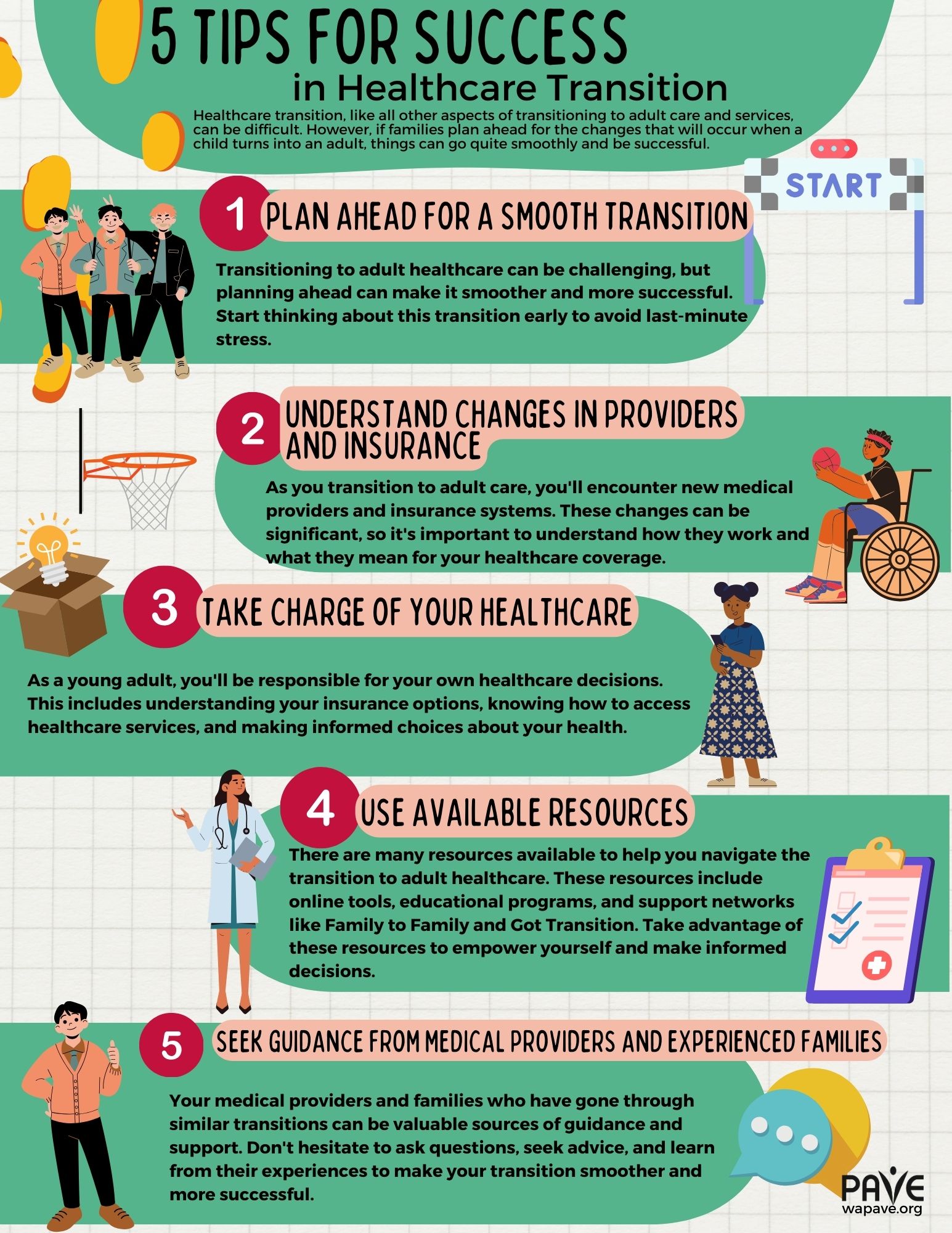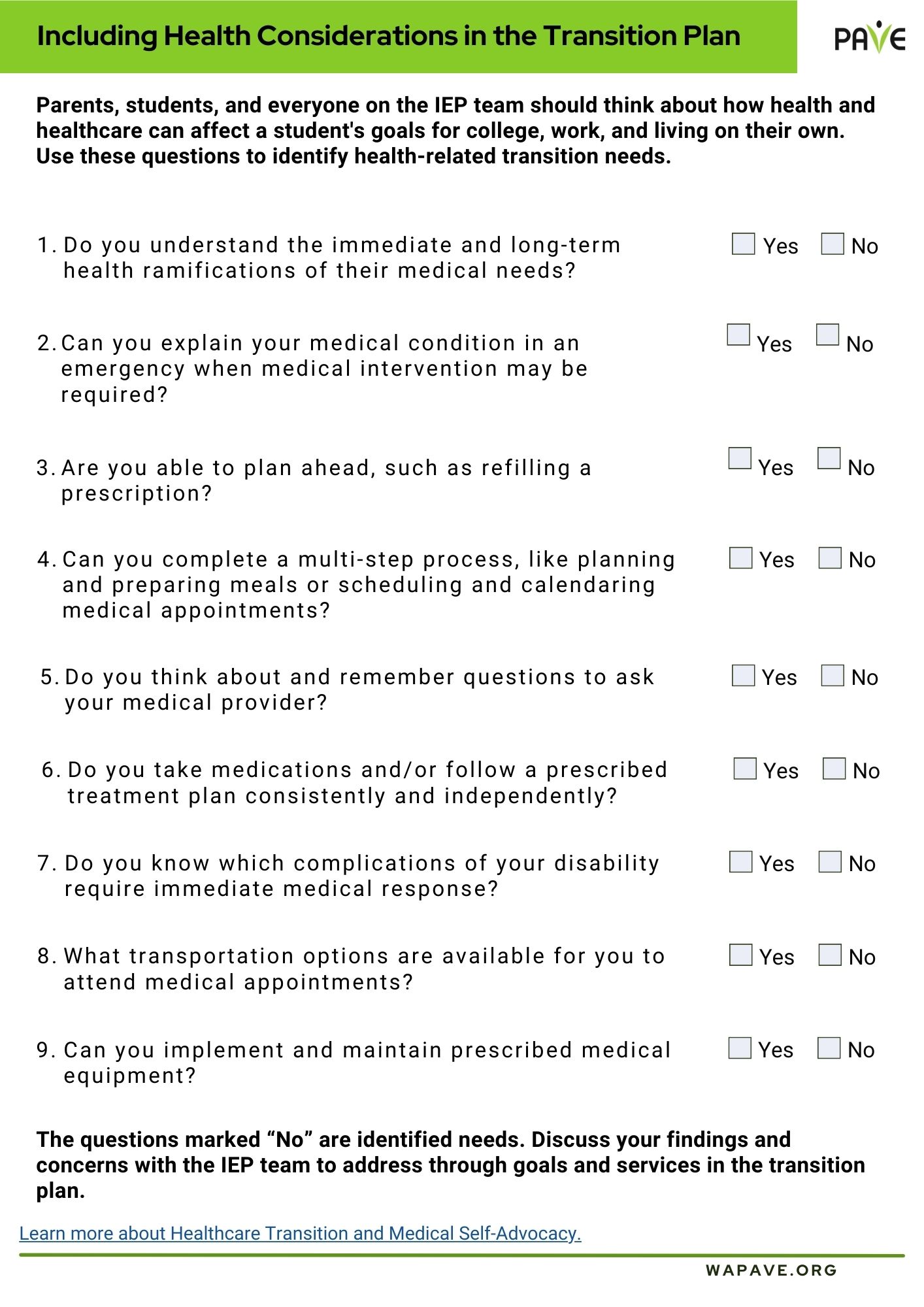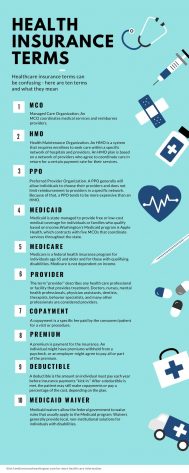A Brief Overview
- At school, related services help children with disabilities benefit from their special education by providing extra help and support. Options for related services are described in state law (WAC 392-172A-01155).
- If a child with public health insurance needs specific therapies to meet medical needs, their insurance company is obligated to support those needs. Medical necessity is described in state law (WAC 182-500-0070).
- Sometimes a service meets educational and medical needs. In those situations, the school might bill Medicaid directly, with parent permission. Families can learn more about School-Based Health Services (SBHS) and ask if their school is participating in this optional program.
- Washington’s Office of Superintendent of Public Instruction (OSPI) issued guidance in August 2022 to clarify that all parts of a student’s IEP begin with the start of school unless an IEP team has agreed to shift something to meet a student-centered need. Schools may not delay the start of related services for their own reasons related to scheduling or resources.
- For federal information about the range of options for related services provided by the school, see parentcenterhub.org.
Full Article
Children with disabilities have a range of needs that may be educational, medical, or both. As they grow, develop, and learn, those needs can shift. How family, school, and medical providers respond can impact how much progress the child makes in their emerging skills. This article includes information to help families understand how therapeutic services may be provided at school or elsewhere.
What are related services?
Schools call services that lie outside the scope of traditional teaching “related services.” Another term is “ancillary services.” Related services help children with disabilities benefit from their special education by providing extra help and support.
Therapies for disabilities that impact physical movement or speech are common. Transportation provided through the special education system also is a common related service. Less common in Washington State are in-school mental health services or counseling for behavioral health conditions. Various possibilities are listed in state law (WAC 392-172A-01155). Here are examples from the Washington Administrative Code (WAC):
- Occupational, Physical, Speech Therapies
- Counseling
- Psychological Services
- Behavioral Services
- School Social Worker
- Special Transportation
- Parent Training
What does parent training mean?
Notice that the final option on this list is parent training. This service might mean the school helps parents understand the special needs of their child or something about their child’s development. Through the related service of parent training, the school can teach family members to help their child practice emerging skills when they’re at home.
Who provides a related service, and who pays?
A related service may be provided by any professional who is trained to assess and/or serve a specific need for a child with a disability condition that affects their learning or development.
When therapeutic services are paid for through medical insurance, they generally must meet a standard of being “medically necessary.” Keep reading for more information about therapeutic services available through the medical system.
Services are provided at school when they are determined to be “educationally necessary.” In those cases, the school district is responsible for payment.
Sometimes a service is both medically and educationally necessary. Sometimes schools seek parent consent to bill the student’s insurance to fund all or part of a related service. Washington State’s Health Care Authority (HCA) manages a program to reimburse schools for services provided to students who are eligible for Apple Health when those services are delivered as part of their Individualized Education Program (IEP).
Tip: See HCA’s website page about School-Based Health Services (SBHS) and consider asking your school if they are participating in this optional program. The guidebook includes information about allowable services. Note that Applied Behavior Analysis (ABA) therapy is explicitly excluded as a reimbursable service through the state’s SBHS program. Most other therapeutic options are reimbursable, including a range of mental health services.
A related service might be part of evaluation
Sometimes a related service is needed to assess a student because school staff do not have the expertise to properly understand a disability condition in order to make service recommendations. “Medical services for diagnostic or evaluation purposes” are written into federal law (IDEA Section 1432) as something an IEP can provide.
Keep in mind that special education evaluations must be comprehensive, in order to identify all of a child’s special education and related service needs, not just those that relate to the IEP eligibility category.
Families can seek an Independent Educational Evaluation (IEE) if they disagree with the methods or conclusions of a school district special education evaluation. PAVE provides an article and sample letter for requesting an IEE.
Related services support FAPE
The federal law that governs special education services is the Individuals with Disabilities Education Act (IDEA). The IDEA makes clear that its list of related services (see below) includes possibilities and options but does not include every related service a student might need. Other therapeutic services might be included in the IEP if they are educationally necessary.
Access and equity are protected by various educational and civil rights laws; anything that helps a student access school-related opportunities can be included as part of a student’s services. Extracurricular activities and school-sponsored sports count.
An IEP is a written commitment for the school to serve a student’s educational needs. Educational needs might be academic, social-emotional, or something else. They might have to do with how the student functions or adapts to the environment of school.
Educational needs are determined through a comprehensive evaluation and a collaborative process that includes family, school staff, and anyone else with knowledge of the student and their disability-related needs. If an IEP team decides that a service is necessary for the student to access their right to a Free Appropriate Public Education (FAPE), then the school district is responsible to deliver those services.
IDEA does not expressly require that the IEP team include related services personnel. However, if a particular need or related service is discussed in an IEP meeting, it would be appropriate for the provider to attend. IDEA states that, at the discretion of the parent or the public agency, “other individuals who have knowledge or special expertise regarding the child, including related services personnel as appropriate” may be part of a child’s IEP team.
School-based related services might include, but are not limited to:
- speech-language pathology and audiology services
- interpreting services
- psychological services
- physical and occupational therapy
- recreation, including therapeutic recreation
- early identification and assessment of disabilities in children
- counseling services, including rehabilitation counseling
- orientation and mobility services for blindness/low vision
- medical services for diagnostic or evaluation purposes
- school health services and school nurse services
- social work services in schools
- parent counseling and training
The national Center for Parent Information and Resources (parentcenterhub.org) provides additional information about each of these possible related services and what they might look like for a student receiving them as part of an Individualized Education Program (IEP).
IEP services start on Day 1 unless the student needs something different
Washington’s Office of Superintendent of Public Instruction (OSPI) issued guidance in August 2022 to clarify that all parts of a student’s IEP begin with the start of school unless an IEP team has agreed to shift something to meet a student-centered need.
According to OSPI, “School districts are reminded that they cannot arbitrarily determine when special education and related services will begin or schedule them to begin after the start of the school year for some providers.”
OSPI’s guidance references a parent complaint and the state’s decision that schools cannot delay the start of certain services because of provider availability or district scheduling preferences. If it’s in the IEP, then the school is responsible to provide the service on all scheduled days that the student attends school. If services aren’t provided as scheduled by the IEP, then the IEP team can discuss how and when the student will receive compensatory services to make up the missed time.
Families have the right to file a complaint with the state if the school does not fully serve their student’s IEP. One option is the community complaint: PAVE provides a video describing that process. Another option is Due Process. The Procedural Safeguards describe all dispute resolution options that are free for families and protected rights under federal and state laws.
Options for therapeutic services through the Medicaid system
If a child needs specific therapies to meet medical needs, their insurance company is obligated to support those needs. For children younger than 21 with Medicaid (Apple Health in Washington), medical necessity is determined through assessments that are a protected benefit called Early Screening and Periodic Screening, Diagnostic and Treatment (EPSDT). This screening process is overseen by the National Academy for State Health Policy (NASHP).
For help navigating complex medical issues, families can request case management from their insurance provider. Calling the number on your insurance card and asking if there a form for requesting case management is a way to begin. Sometimes a case manager is automatically assigned if claims become complex and expensive.
Medical criteria are different than school criteria. While school-based services are built to support a student’s educational access, EPSDT determinations are made to support safety and health in the home and community. Here are examples:
- Physical Therapy (PT) at school might support adapted physical education (PE) or help the student navigate the school building or curriculum. Outside of school, PT can support navigating the home, community, recreational activities, and more.
- Speech/language services at school are tailored to help the student achieve goals on their Individualized Education Program (IEP) or access their curriculum. Outside of school, speech/language services can expand to support communication for daily living and might be paired with Occupational Therapy (OT), for example, to work on feeding issues, sensory aversions, breathing challenges, alternative communication systems, and more.
Services to support access to school, home, and community might intertwine, and the school district might choose to bill Medicaid for reimbursement, with the family’s signed consent.
TIP: If the school is going to bill insurance, families may want to find out if the insurance company has a reimbursement limit for the service. If the child is getting a similar service in and out of school, care coordination is important to make sure all the services will be paid. Insurance may be willing to pay for more services if it’s clear which are for school-based needs and which are medical. Those details also may be important to note if services are denied and the family wants to appeal the denial through a medical or special education complaint option.
What meets the standard of medical necessity?
The Washington Administrative Code (WAC 182-500-0070) describes medical necessity. If a service is likely to prevent, diagnose, or treat an identified condition that is causing major life impacts, then it may meet the standard. The WAC says medical necessity is:
“…a term for describing requested service which is reasonably calculated to prevent, diagnose, correct, cure, alleviate or prevent worsening of conditions in the client that endanger life, or cause suffering or pain, or result in an illness or infirmity, or threaten to cause or aggravate a handicap, or cause physical deformity or malfunction.”
The same WAC goes on to say that all federally funded insurance is obligated to pay for a service if it’s the most reasonable option available to serve the need. That standard is met when:
“There is no other equally effective, more conservative or substantially less costly course of treatment available or suitable for the client requesting the service.”
The same WAC also explains that a chosen course of treatment might mean a choice to track a condition through observation or offer no treatment. The WAC says:
“For the purposes of this section, ‘course of treatment’ may include mere observation or, where appropriate, no medical treatment at all.”
A medical specialist, therapist, or pediatrician might assess the child to determine whether a specific service is medically necessary. In some situations, a case manager from the state’s Developmental Disabilities Administration (DDA) may make the determination.
What about private insurance?
Families with insurance through an employer or the healthcare exchange will need to ask their provider for specific information about what therapeutic services are covered. A company’s human resources department is another place to ask about coverages and whether there is a choice of health plan with more allowable options. School-based services may be the only option for some, as medical parity laws do not protect all possible therapeutic services.
Here are a places to get support in understanding your health plan and navigating access to services:
Insurance denials for employer-based plans can be appealed through:
PAVE’s Family to Family (F2F) Health Information Center provides additional information and resources through it’s website, Family Voices of Washington. Click Get Help at wapave.org to request individualized support.




